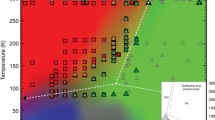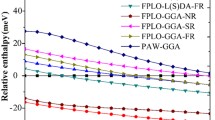Abstract
External pressure applied to a solid material causes modifications of the bonding which can provide a chemical explanations of phase transitions. The behaviour of the Electron Localization Function (ELF) has been examined for the body-centred cubic, face-centred cubic and \(I\bar 43d-16\) phase of lithium for a series of cell volumes accounting for external hydrostatic pressures in the 0-60 GPa range. It is shown that the ELF signatures of electron localization increase with the pressure. Moreover, the number of basins per atom is the high-pressure phases is less than in the low-pressure ones and therefore the basin population are larger in high pressure modifications. These results complement the study of Marques et al. Phys Rev Lett 106:095502 (2011) carried out on the C2c b − 40 and C m c a − 24 phases stable above 85 GPa.



Similar content being viewed by others
Notes
The notation {s 1,s 2,s 3,…/p 1,p 2,…/d 1,…} specifies the number of primitives of each type in the contraction.
References
Marqués M, McMahon MI, Gregoryanz E, Hanfland M, Guillaume CL, Pickard CJ, Ackland GJ, Nelmes RJ (2011) Crystal Structures of Dense Lithium: A metal-semiconductor-metal transition. Phys Rev Lett 106:095502
Gavezzotti A (1994) Are crystal structures predictable? Acc Chem Res 27:309–314
Guillaume CL, Gregoryanz E, Degtyareva O, McMahon MI, Hanfland, M, Evans S, Guthrie M, Sinogeikin SV, Mao HK (2011) Cold melting and solid structures of dense lithium. Nat Phys 7:211–214
Matsuoka T, Shimizu K (2009) Direct observation of a pressure-induced metal-to-semiconductor transition in lithium. Nature 458:186–189
Neaton JB, Ashcroft NW (1999) Pairing in dense lithium. Nature 400:141–144
Rousseau R, Marx D (2000) Exploring the electronic structure of elemental lithium: from small molecules to nanoclusters. Bulk Metal, Surf Chem Eur J 6:2982–2993
Car R, Parrinello M (1985) Unified approach for molecular dynamics and density-functional theory. Chem Phys Lett :2471–2474
Becke AD, Edgecombe KE (1990) A simple measure of electron localization in atomic and molecular systems. J Chem Phys 92:5397–5403
Kittel C (1963) Quantum theory of solids. Wiley, New York
Ashcroft NW, Mermin ND (1976) Solid state physics Saunders College Publishing
Lewis GN (1966) Valence and the structure of atoms and molecules Dover, New York
Pauling L (1948) The nature of the chemical bond. Cornell University Press, Ithaca
Anderson WP, Burdett JK, Czech PT (1994) What is the metallic bond? J Am Chem Soc 116:8808–8809
Allen LC, Capitani JF (1994) What is the metallic bond? J Am Chem Soc 116:8810–8810
Li M, Goddard WA III (1989) Interstitial-electron model for lattice in fcc metals. Phys Rev B 40:12155–12163
Bader RFW (1990) Atoms in molecules: a quantum theory. Oxford University Press, Oxford
Martín Pendás A, Blanco MA, Costales A, Mori Sánchez P, Luaña V (1999) Non-nuclear maxima of the electron density. Phys Rev Lett 83:1930–1933
Cao WL, Gatti C, MacDougall PJ, Bader RFW (1987) On the presence of nonnuclear attractors in the charge distribution of Li and Na cluster. Chem Phys Lett 141:380–385
Cioslowski J (1990) Nonnuclear attractors in the Li 2 molecule. J Phys Chem 94:5496–5498
Mei C, Edgecombe KE, Smith VH Jr, Heilingbrunner A (1993) Topological analysis of the charge density of solids: bcc sodium and lithium. Int J Quant Chem 48:287–293
Iversen BB, Larsen FK, Souhassou M, Takata M (1995) Experimental evidence for the existence of non-nuclear maxima in the electron-density distribution of metallic beryllium. A comparative study of the maximum entropy method and the multipole refinement method. Acta Cryst B 51:580–591
Silvi B, Gatti C (2000) Direct space representation of the metallic bond. J Phys Chem A 104:947–953
Baranov AI, Kohout M (2008) Electron localizability for hexagonal element structures. J Comput Chem 29:2161–2171
Bader RFW (1994) Principle of stationary action and the definition of a proper open system. Phys Rev B 49:13348–13356
Bader RFW (2001) The zero-flux surface and the topological and quantum definition of an atom in a molecule. Theor Chem Acc 105:276–283
Bader RFW (2005) The quantum mechanical basis of conceptual chemistry. Monatsh Chem 136:819–854
Bader RFW (2007) Everyman’s derivation of the theory of atoms in molecules. J Phys Chem A 111:7966–7972
Bader RFW (2007) The lagrangian approach to chemistry. In: Matta CF, Boyd RJ (eds) The Quantum Theory of Atoms in Molecules: From Solid State to DNA and Drug Design. Wiley, New York, pp 37–59
Martín Pendás A, Blanco MA, Francisco E (2004) Two-electron integrations in the quantum theory of atoms in molecules. J Chem Phys 120:4581–4592
Martín Pendás A, Francisco E, Blanco MA (2005) Two-electron integrations in the Quantum Theory of Atoms in Molecules with correlated wave functions. J Comput Chem 26:
Blanco MA, Martín Pendás A, Francisco E (2005) Interacting quantum atoms: A correlated energy decomposition scheme based on the quantum theory of atoms in molecules. J Chem Theory Comput 1:1096–1109
Francisco E, Martín Pendás A, Blanco MA (2006) A molecular energy decomposition scheme for atoms in molecules. J Chem Theory Comput 2:90–102
Bader RFW (1998) A bond path: A universal indicator of bonded interactions. J Phys Chem A 102:7314
Bader RFW, Essén H (1984) The characterization of atomic interactions. J Chem Phys 80:1943–1960
Cremer D, Kraka E (1984) Chemical bonds without bonding electron density - does the difference electron-density analysis suffice for a description of the chemical bond? Angew Chem Int Ed Engl 23:627–628
Cremer D, Kraka E (1983) A description of the chemical bond in terms of local properties of the electron density and energy. Croat Chem Acta 57:1259–1281
Kraka E, Cremer D (1992) Description of chemical reactions in terms of the properties of the electron density. J Mol Struct Theochem 255:189–206
Macchi P, Proserpio DM, Sironi A (1998) Experimental electron density in a transition metal dimer: Metal-metal and metal-ligand bonds. J Am Chem Soc 120:13429–13435
Macchi P, Sironi A (2003) Chemical bonding in transition metal carbonyl clusters: Complementary analysis of theoretical and experimental electron densities. Coord Chem Rev 238-239:383–412
Bianchi R, Gervasio G, Marabello D (2000) Experimental electron density analysis of Mn(CO) 10: Metal-metal and metal-ligand bond characterization. Inorg Chem 39:2360–2366
Mori-Sánchez P, Martín Pendás A, Luaña V (2002) A classification of covalent, ionic, and metallic solids based on the electron density. J Am Chem Soc 124:14721–14723
Jenkins S, Ayers P, Kirk S, Mori-Sánchez P, Martín Pendás A (2009) Bond metallicity of materials from real space charge density distributions. Chem Phys Lett 471:174–177
Diner S, Claverie P (1976) Statistical and stochastic aspects of the delocalization problem in quantum mechanics. In: Chalvet O, Daudel R, Diner S, Malrieu JP (eds) Localization and delocalization in quantum chemistry, vol II. Reidel, Dordrecht, pp 395– 448
Silvi B, Fourré I, Alikhani E (2005) The topological analysis of the electron localization function: a key for a position space representation of chemical bonds. Monatsh Chem 136:855–879
Ayers PW (2005) Electron localization functions and local measures of the covariance. J Chem Sci 117:441–454
Burdett JK, McCormick TA (1998) Electron localization in molecules and solids: the meaning of ELF. J Phys Chem A 102:6366–6372
Nalewajski RF, Koster AM, Escalante S (2005) Electron localization function as information measure. J Phys Chem A 109:10038–10043
Dobson JF (1991) Interpretation of the Fermi hole curvature. J Chem Phys 94:4328–4333
Kohout M, Pernal K, Wagner FR, Grin Y (2004) Electron localizability indicator for correlated wavefunctions. I. Parallel spin pairs. Theor Chem Acc 112:453–459
Wagner FR, Bezugly V, Kohout M, Grin Y (2007) Charge decomposition analysis of the electron localizability indicator: a bridge between the orbital and direct space representation of the chemical bond. Chem Eur J 13:5724–5741
Silvi B (2003) The spin pair compositions as local indicators of the nature of the bonding. J Phys Chem A 107:3081–3085
Matito E, Silvi B, Duran M, Solà M (2006) Electron localization function at the correlated level. J Chem Phys 125:024301
Feixas F, Matito E, Duran M, Solá M, Silvi B (2010) Electron localization function at the correlated level: a natural orbital formulation. J Chem Theory Comput 6:2736–2742
Silvi B, Savin A (1994) Classification of chemical bonds based on topological analysis of electron localization function. Nature 371:683–686
Häussermann U, Wengert S, Nesper R (1994) Unequivocal partitioning of crystal structures. Exemplified by intermetallic phases containing aluminium. Angew Chem Int Ed Engl 33:2073–2076
Gillespie RJ, Robinson EA (2007) Models of molecular geometry. J Comput Chem 28:87–97
Savin A, Silvi B, Colonna F (1996) Topological analysis of the electron localization function applied to delocalized bonds. Can J Chem 74:1088–1096
Kohout M, Wagner FR, Grin Y (2002) Electron localization function for transition-metal compounds. Theor Chem Acc 108:150–156
Calatayud M, Andrés J, Beltrán A, Silvi B (2001) The hierarchy of localization basins: a tool for the understanding of chemical bonding exemplified by the analysis of the VO x and VO x+ (x=1-4) systems. Theoret Chem Acc 105:299–308
Silvi B, Ratajczak H (2016) Hydrogen bonding and delocalization in the ELF analysis approach. Phys Chem ChemPhys 18:27442–27449
Thom R (1972) Stabilité Structurelle et Morphogénèse Intereditions, Paris
Saunders VR, Dovesi R, Roetti C, Causà M, Harrison NM, Orlando R, Zicovitch-Wilson CM (1998) CRYSTAL98. User’s manual Torino, Italy
Schäfer A, Huber C, Ahlrichs R (1994) Fully optimized contracted Gaussian basis sets of triple zeta valence quality for atoms Li to Kr. J Chem Phys 100:5829–5835
Perdew JP, Wang Y (1992) Accurate and simple analytic representation of the electron-gas correlation energy. Phys Rev B 45:13244–13249
Gatti C (1998) Topond98 manual CNR-CSRSRC. Milano, Italy
Noury S, Krokidis X, Fuster F, Silvi B (1999) Computational tools for the electron localization function topological analysis. Comput Chem 23:597–604
Acura CL (2002) Amira 3.0 TGS. Template Graphics Sofware, Inc., San Diego, USA
Gschneidner KA Jr (1964) Physical properties and interrelationships of metallic and semimetallic elements. In: Seitz F, Turnbull D (eds) Solid State Physics, vol 16. Academic Press, pp 275–426
Hanfland M, Loa I, Syassen K, Schwarz U, Takemura K (1999) Equation of state of lithium to 21 GPa. Solid State Commun 112:123 – 127
Ormeci A, Rosner H, Wagner F, Kohout M, Grin Y (2006) Electron localization function in full-potential representation for crystalline materials. J Phys Chem A 110:1100–1105
Savin A, Becke AD, Flad J, Nesper R, Preuss H, Von Schnering HG (1991) A new look at electron localization. Angew Chem Int Ed Engl 30:409
Savin A, Jepsen O, Flad J, Andersen OK, Preuss H, von Schnering HG (1992) Electron localization in the solid-state structures of the elements: The diamond structure. Angew Chem Int Ed Engl 31:187–190
Savin A, Nesper R, Wengert S, Fässler TF (1997) ELF: The electron localization function. Angew Chem Int Ed Engl 36:1809–1832
Alikhani ME, Shaik S (2006) A topological study of the ferromagnetic “no-pair bonding” in maximum-spin lithium clusters: Li-n+1(n)(n = 2-6). Theor Chem Acc 116:390–397
Contreras-Garcá J, Martín Pendás A, Silvi B, Recio JM (2008) Useful applications of the electron localization function in high-pressure crystal chemistry. J Phys Chem Solids 69:2204– 2207
Contreras-Garcia J, Mori-Sanchez P, Silvi B, Recio JM (2009) A quantum chemical interpretation of compressibility in solids. J Chem Theory Comput 5:2108–2114
Author information
Authors and Affiliations
Corresponding author
Ethics declarations
This theoretical work meets the requirements of the ethical standards.
Additional information
This paper is dedicated to Professor Lou Massa on the occasion of his Festschrift
Rights and permissions
About this article
Cite this article
Silvi, B. Pressure effect on electron localization in solid lithium. Struct Chem 28, 1389–1397 (2017). https://doi.org/10.1007/s11224-017-0962-7
Received:
Accepted:
Published:
Issue Date:
DOI: https://doi.org/10.1007/s11224-017-0962-7




